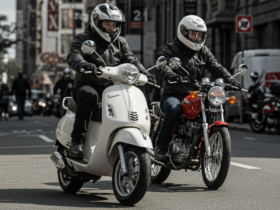Do you recall how both celebrities and influencers helped market hoverboards as the next big futuristic gizmos in 2015? It did not take long for them to blow up as they quickly became the talk of the town. Everyday people started using them, too. Fast forward to 2025, and you might be wondering to yourself: are hoverboards still relevant?
In this article, we’ll take a deep look into the life of hoverboards in 2025. From the way they gained popularity to the current market trends, we will analyze if they are still worth buying in 2025 or have they become obsolete.
What Exactly Are Hoverboards?
Before focusing on whether hoverboards are still a big deal in 2025, it is of utmost importance to understand what a hoverboard actually is. Contrary to what its name suggests, they do not ‘hover’, but are rather self balancing scooters powered by electric motors and gyroscopes.
Definition of Hoverboards
In case you didn’t know, hoverboards—commonly referred to as self balancing scooters—are two wheeled, electric devices that are meant for personal transportation. It features a platform where users can stand and lean their body to shift direction. Leaning forward moves the device forward while backward tends to reverse or slow down.
Components of a Hoverboard
Motor: The motor provides power to the system, enabling movement. Even though a hoverboard’s motor is relatively miniature, it is powerful enough to transport the rider from one destination to another.
Battery: Powering hoverboards requires the use of rechargeable lithium ion batteries. Depending on the usage and terrain, these batteries usually sustain power for around 1 to 2 hours on a full charge.
Sensors: In maintaining the upright position of a hoverboard, gyroscopes and accelerometers help balance the rider by detecting shifts in weight, which enables hoverboards to maintain their upright position.
Wheels: The wheels are primarily composed of strong rubber which makes them shock absorbing and smoother riding on flat surfaces.
Why Were Hoverboards So Popular?
The advent of hoverboards brought with it instant popularity as a new gadget for children and adults. But what was it that drove it to become so widely accepted so quickly?
Initial Hype in 2015
The crowning moment of a hoverboard’s existence seemed to be when it first burst onto the market. The popularity it achieved can be credited to social media. Influencers as well as celebrities like Justin Bieber and Khloe Kardashian rode them in public and thier fans lost their heads. Riding a hoverboard seemed to become a fad instantly.
Accessibility and Fun Factor
The ease of riding hoverboards is most likely the fact is was fairly basic. One only needed to step on it and it was designed to automatically operate based on how the rider shifted his or her weight.
For a lot of people, it was an entertaining means of transportation and riding one gave them the thrill of seemingly living in the future as it felt like they were riding a gadget from a science fiction novel.
Affordable for the Masses
In the earlier years, hoverboards were available at varying prices. Some models were relatively inexpensive and appealed to buyers who sought effortless mobility and did not want to hurt their wallet. This surge in demand during the early period made hoverboards more affordable to a larger population.
What Happened to Hoverboards After the Initial Hype?
The major downside is that, despite the overwhelming success early on, hoverboards eventually went through a dip. The question remains, why?
Safety Concerns
As hoverboards gained more users, so did the safety concerns associated with them. Reports suggested hoverboards bursting into flames due to loose and unregulated batteries in cheaper uncertified variants. Product recalls followed and certain models were prohibited from being transported via planes and restricted in various public locations due to severe safety concerns.
Regulations and Bans
The U.S Consumer Product Safety Commission (CPSC) took it upon themselves to cut the safety hazards and set forth regulations on the use of hoverboards. Entire countries, as well as multiple cities, imposed bans or restrictions for hoverboards in specific regions like riding them on public roads and sidewalks.
Competition from Other Technologies
The possible risks and regulatory problems that hoverboards encountered led to the increased popularity of other electric mobility devices. Electric scooters, bikes, and other personal modes of electric transport were far more convenient and practical to many individuals. These devices were user friendly, more versatile, and work better in towns and cities.
Are Hoverboards Still Relevant in 2025?
Have hoverboards faded into obscurity or are they still making waves in 2025? Let us take a deeper look on the current state of hoverboards.
Current Popularity
Hoverboards do not dominate the headlines the same way they did back in 2015, but are still recognized in the market. Their presence may not be as great, but in the last eight years, many manufacturers have improved designs and safety features. These upgrades allows hoverboards to remain as a niche product.
Target Market
From hoverboards being a mainstream trend, they have now narrowed to a specific target market. In 2025, they are still common among consumers from younger age groups, especially teens and kids. This, however, does not apply for those who are looking for practical forms of transportation. Recreational riding is another reason these age groups enjoy hoverboards.
Public Perception
Currently hoverboards are viewed as fun gadgets, more than the great innovative technology they were assumed to be. From the start, some people use them for short trips to show off to friends, while others see it as a fad that gets boring once the novelty wears off.
Technological Improvements in Hoverboards
Even though hoverboards did not live up to their expectations, they have certainly advanced in their technologies. Let us look at some of the improvements made in recent years.
Battery Life and Charging Technology
What hindered older hoverboard models was their range, since riders often complained how their boards could barely last an hour before needing a charge.
In comparison with the previous versions, hoverboards launched in 2025 offer longer-lasting lithium-ion batteries which enable riders to travel farther and recharge faster. In fact, some models offer fast-charging options so you can get back on the road quicker.
Speed and Range Improvements
In the earlier years, hoverboards had restricted range and speed. Nowadays, many hoverboards are able to reach a speed between 10-15 miles per hour, with some models able to travel around 12 miles on a single charge. All of this makes them far more useful for short commutes and recreational uses.
Enhanced Safety Features
With the invention of hoverboards, their safety protocols were a cause for concern. Now, in 2025, hoverboard safety technologies have advanced tremendously. Today’s hoverboards are fitted with UL certified batteries, fire resistant materials, and advanced stability systems that substantially reduce the chances of hoverboard accidents.
Smart Features
Modern hoverboard models come with Bluetooth capabilities which enables users to connect their hoverboard to smart devices for tracking, music, and app-based control. Some even come equipped with GPS so users can track their hoverboard if lost or stolen.
Practical Uses for Hoverboards in 2025
In 2025, hoverboards are no longer regarded as a revolutionary mode of transport but they do still serve specific purposes. Let us delve into 2025’s practical hoverboard use.
Recreational Use
Hoverboards are, and will remain, a recreational device popular amongst most young people. Whether riding around the neighborhood or out practicing various tricks, hoverboard riders can always count on fun and excitement.
Urban Mobility and Short Commuting
As far as some metropolitan areas are concerned, hoverboards have utility in short distance comuting. With regard to getting around a college campus, park, or small town, hoverboards provide an easy and quick means of transport.
Fitness and Balance Training
To the surprise of many, hoverboards are being utilized for balance and fitness training. They are not only a workout tool, but they can also improve riders’ balance and coordination.
Pros of Hoverboards in 2025
Even with the fluctuations, hoverboards provide a number of benefits in 2025.
Portability
Due to their light weight and compact size, hoverboards are ideal for short-distance travel. They can be carried or stored with ease, whether one is walking to the bus stop or just roaming around.
Affordability
In comparison to electric bikes and scooters, hoverboards are much cheaper in 2025, despite the availability of expensive models. Beginner users on a budget would greatly benefit from purchasing a hoverboard.
Fun and Easy to Learn
With the added safety and stability features, hoverboards are easy to learn for beginners, making it a fun experience for everyone, regardless of their age.
You can also read How often should you really change oil in 2025?
Cons of Hoverboards in 2025
With the additional pros hoverboards have, they also come with lacking cons.
Limited Range and Speed
For the time being, hoverboards are not the best tool for wide-ranging travel as they can hover between 10 to 15 miles only. This makes them ideal for short trips but not long commutes.
Safety Concerns
Even with increased technology, hoverboards can still be dangerous. For a complete learner, falling is one of the strong possibilities due to inbuilt risk factors and accidents are still part of the game for children and inexperienced riders.
Weather Dependency
Unlike any other transportation, hoverboards show better performance in clear dry weather. Wet and icy roads are the only danger to hoverboards and these conditions make them weak.
My Opinion
Hoverboards have yet to fulfill the expectations that come with them. Until that gap shrinks, we have these self balancing scooters as a leisure tool and a practical accessory in 2025.
If you want a tool that helps you progress short distances in a more entertaining way, or even helps you commute, you should definitely consider these. More pragmatic needs for transportation should be directed towards other riders like e-scooters and e-bikes where efficiency is their trade mark.

















Leave a Reply